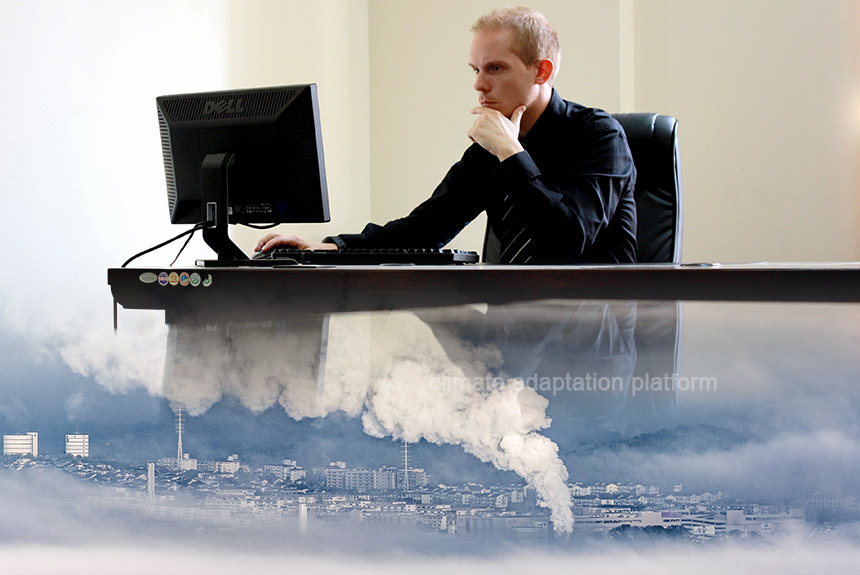Manufacturing, financial institutions, construction, agriculture, real estate, service providers, and information tech companies will be affected by extreme events made more frequent and intense by climate change. No business is immune to the impacts of climate change.
Damages in physical assets, disruptions in services, supply chain failure, and workers- absence because they cannot access places of work or suffer health impacts of climate change can disrupt or halt business operations.
An article in PWC, “How climate adaptation can both protect and grow your business,” underscores that adapting to climate change is vital if companies want to continue to exist or grow in the face of increasing and intensifying extreme events.
Much of the focus has been on reducing carbon emissions, a measure known as climate mitigation. But global emissions are on the rise. The World Meteorological Organization (WMO) predicts that there is now a 66% chance that the average global temperature will exceed 1.5°C above pre-industrial levels for at least one year between 2023 and 2027, which underscores why businesses must also focus on implementing climate adaptation strategies.
Only a small percentage, 17% of Global CEO respondents, say they have implemented climate adaptation to protect their workforce or physical assets from climate change. Yet, losses from climate change are escalating. The article notes the estimate from the European Environment Agency of climate-change-related loss in the European Union in the last ten years at €145 billion (US$159 billion) – losses set to rise as extreme events become more common and intense.
The article looks at the business risks from climate change, how climate adaptation can prevent or reduce these risks, how companies established capabilities can be tapped to support climate adaptation and resilience, and what additional steps they can take to create value. The article also gives examples of businesses already implementing climate adaptation strategies.
Most businesses already have policies to help them deal with any risks, and they could extend them to prepare for climate change.
The article mentions that, fortunately, some organisations can handle these situations. Most companies have enterprise-wide business continuity programs to help them gauge risk exposure and prepare for terrorist attacks, cyber threats, and health crises (Vox, Carma, & Cappell, 2023).
Vox, Carma, & Cappell (2023) mention: “They can also extend these programs to address climate risks. The aim in this case—just as with other types of risks—is to build long-term resilience by identifying mission-critical processes, creating backup strategies, and training employees in crisis response through tests, drills, and simulation exercises.”
Climate adaptation is an ongoing process.
The article put forward three vital, repeatable steps to help businesses start plotting their company’s adaptation journey.
- First, identify and analyse risks stemming from the businesses’ physical location, communities in which they operate, value chain, and market.
- Second, develop action plans.
- Lastly, enlist support and collaborate with governments, stakeholders, and communities to develop adaptation solutions and promote actions on climate change adaptation.
Early adopters of climate adaptation
The article cites businesses from organisations that seek to accelerate climate change to insurance companies to a building materials company, and partnerships between Meta, a gas and electric business, and the city government in Menlo Park, a city in California that came together to build a levee as a climate adaptation solution.
The Global Center on Adaptation built a three-storey floating office building in the Netherlands to adapt to sea level rise and constant threats of floods. The structure is also made of wood, a low-emissions material, with solar panels and a green roof that absorbs rainwater runoff.
Insurer Swiss Re designed a new insurance product to support the protection of the coral reef in Mexico’s Yucatán Peninsula against climate-related damages, and a Florida-based building material company has significantly increased their sales using a climate tool in the form of AI to forecast the weather.
These are just a few examples of how businesses can protect, expand, and thrive under a changing climate change.
Learn more about how climate adaptation can help businesses grow and take advantage of opportunities by visiting the link in the “Sources” below.
Source:
Cox, E., Varma, A, & Cappell, E. (2023 August 15). PWC. Retrieved from https://www.pwc.com/gx/en/issues/esg/how-climate-adaptation-can-both-protect-and-grow-your-business.html



Leave a Reply